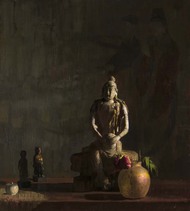Events / Exhibitions
24.09.2013 - 24.10.2013
“Time of Hope, Struggle and Creative work”
The National Gallery of Armenia is going to welcome an exhibition named “Time of Hope, Struggle and Creative work” on September 24, at 15.00 pm. The exhibition will include artworks dedicated to the art of socialist realism.The social-political and cultural life in Armenia as well as in Russia suddenly changed in the middle of the 20th century. The searches for new subjects of painting and descriptive solutions in the 19th century contributed to the formation of new creative groups and diversity of styles. The 1917 revolution sped up this process under the slogan of proletarian art. At the beginning of 1930’s the “socialist realism” was proclaimed as the unified artistic style of soviet art.
The exhibited artworks give an idea of the formation of the main genres of soviet painting during 1920 - 1930s. Those genres include historical-revolutionary genre, portraiture, as well as “industrial” landscape genre, which was an innovation for the artists of the time. I Mashkov and V. Rozhdestvensky are among its representatives.
The exhibited artworks reflect the diversity of stylistic trends in the frame of the unified declared official art. Portraits of one of the founders of the Artists’ Association of the Revolutionary Russia (AARR) I. Vladimirov depict collective farmers who are emotional and expressive. The canvases of the founder of “Union of Easel Painters” P. Williams introduce the dancing representatives of soviet republics which are artistic and happy. The echoes of 1920s artistic debates have left traces in the artworks of the artists’ next generation represented at the exhibition (A. Maksimenko and others). The creations of F. Modorov stand out among portraits. He was one of those artists of the country who was allowed to portray the leaders of the Soviet Union, personally I. Stalin.
Soviet art was constantly proclaimed to be a multinational art. The art schools of soviet republics were formed during the 19-20th centuries under the influence of All-Russian tendencies at the same time bearing native traditions.
Social-political and cultural tendencies were also expressed in Soviet Armenia. The new developing trend- the socialist realism should be considered in historical context as a changeable trend and at the same time as an inner creative and entire phenomenon. Everywhere the propagated images of socialism founders, their bright future, political and ideological leaders were expressed in art directed to mass perception.
On the whole, art and cultural life were not paid such a special attention by the government as in this period. The following exhibition will display the artworks of the great artists of the period. M. Sarian (1880-1972), S. Arakelian (1884-1942), G. Gyurjian (1892-1987), A. Bekaryan (1913-1986) have formed Armenian Fine Arts, at the same time being unique representatives of socialist realism.
Thematic artworks of S. Rashmajian (1907-1978) and A. Nalbandian (1916-1964) are distinguished for their figurative and interesting shades of landscape (turning to the theme of industrialism, urbanization and collectivization as well).
The landscapes of B. Konturajian (1905-1956) (represented in Salons of Paris and repatriated in 1947) stand out with their tender colouring. Still lifes of Z. Khachatryan (1924) and M. Aslamazian (1907-2006) as well as thematic creations of K. Petrov-Vodkin’s student G. Fermanian (1899-1958) are distinguished by their unique compositional solutions and performance technique.
The portraits of E. Isabekian (1914-2007), M. Kamalian (1915-1971) and H. Zardaryan (1918-1992) depict the images of the representatives of Armenian intellectuals.
